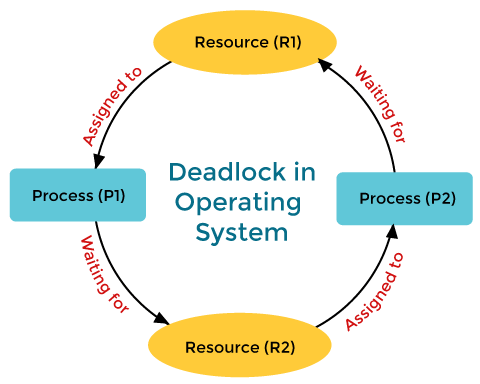Difference between Deadlock and StarvationDeadlock and starvation are conditions in which the processes requesting a resource have been delayed for a long time. However, deadlock and starvation are not the same things in many ways. Deadlock happens when every process holds a resource and waits for another process to hold another resource. In contrast, in starvation, the processes with high priorities continuously consume resources, preventing low priority processes from acquiring resources. In this article, you will learn the difference between deadlock and starvation. But before discussing the difference between deadlock and starvation, you must need to learn about deadlock and starvation. What is deadlock?Deadlock happens when every process holds a resource and waits for another process to hold another resource. In other words, a deadlock occurs when multiple processes in the CPU compete for the limited number of resources available in the CPU. In this context, each process keeps a resource and waits for another process to obtain a resource. 
Let's take an instance, Process (P1) is holding Resource (R1) and waiting for the Process (P2) to acquire the Resource (R2), and Process (P2) is waiting for the Resource (R1). Thus, Both the Process (P1) and (P2) is in a deadlock situation. It is a common issue in multiprogramming OS, parallel computing systems, and distributed systems. There is a deadlock issue when one process requires a process that is requested by another process. Four conditions may occur the condition of deadlock. These are as follows:
Mutual ExclusionOnly one process can utilize a resource at a time; if another process requests the same resource, it must wait until the process that is utilizing it releases it. Hold and WaitA process should be holding a resource when waiting for the acquirer of another process's resource. No PreemptionThe process holding the resources may not be preempted, and the process holding the resources should freely release the resource after it has finished its job. Circular WaitIn a circular form, the process must wait for resources. Let's suppose there are three processes: P0, P1, and P2. P0 must wait for the resource held by P1; P1 must wait for process P2 to acquire the resource held by P2, and P2 must wait for P0 to acquire the process. Although several applications may detect programs that are likely to become deadlocked, the operating system is never in charge of preventing deadlocks. It is the responsibility of programmers to create programs that are free of deadlocks, and it is possible to avoid deadlock by avoiding the conditions listed above. What is Starvation?Starvation happens when a low priority program requests a system resource but cannot run because a higher priority program has been employing that resource for a long time. When a process is ready to start executing, it waits for the CPU to allocate the necessary resources. However, because other processes continue to block the required resources, the process must wait indefinitely. In most priority scheduling algorithms, the problem of starvation arises. The resource is frequently assigned to the higher priority process in a priority scheduling method, which helps to prevent the lower priority process from obtaining the requested resource. Starvation is an issue that can be solved through aging. Aging raises the priority of a procedure that has been waiting for resources for a long period. It also helps to prevent a low-priority procedure from waiting indefinitely for resources. There are some common causes of starvation as follows:
Some solutions that may be implemented in a system that helps to handle starvation are as follows:
Main differences between the deadlock and starvationHere, you will learn the main differences between deadlock and starvation. Various differences between deadlock and starvation are as follows:
Head-to-head comparison between the deadlock and starvation
Here, you will learn the head-to-head comparison between deadlock and starvation. Various head-to-head comparisons between deadlock and starvation are as follows:
ConclusionMultiple processes are executing in an operating system. Both starvation and deadlock are two methods that may happen when there are processes. Deadlock happens when every process holds a resource and waits to obtain a resource held by another process. In contrast, starvation happens when a process waits indefinitely for a required resource. Deadlock may cause processes to starvation, and on the other side, starvation can break the deadlock.
Next TopicSemaphore vs Monitor
|
 For Videos Join Our Youtube Channel: Join Now
For Videos Join Our Youtube Channel: Join Now
Feedback
- Send your Feedback to [email protected]
Help Others, Please Share










